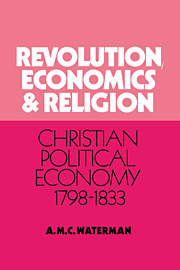Book contents
- Frontmatter
- Contents
- List of figures
- Acknowledgements
- Abbreviations
- 1 POLEMIC, IDEOLOGY AND ‘CHRISTIAN POLITICAL ECONOMY’
- 2 THE FIRST ESSAY ON POPULATION: POLITICAL ECONOMY
- 3 THE FIRST ESSAY ON POPULATION: THEOLOGY
- 4 THE RECONSTRUCTION OF MALTHUSIAN THEODICY: PALEY AND SUMNER
- 5 OXFORD CONTRIBUTIONS: COPLESTON AND WHATELY
- 6 CHALMERS AND THE ESTABLISHMENT
- 7 THE END OF CHRISTIAN POLITICAL ECONOMY
- Appendices: The Malthus–Chalmers model of stationary equilibrium
- Bibliography
- Index
4 - THE RECONSTRUCTION OF MALTHUSIAN THEODICY: PALEY AND SUMNER
Published online by Cambridge University Press: 27 August 2009
- Frontmatter
- Contents
- List of figures
- Acknowledgements
- Abbreviations
- 1 POLEMIC, IDEOLOGY AND ‘CHRISTIAN POLITICAL ECONOMY’
- 2 THE FIRST ESSAY ON POPULATION: POLITICAL ECONOMY
- 3 THE FIRST ESSAY ON POPULATION: THEOLOGY
- 4 THE RECONSTRUCTION OF MALTHUSIAN THEODICY: PALEY AND SUMNER
- 5 OXFORD CONTRIBUTIONS: COPLESTON AND WHATELY
- 6 CHALMERS AND THE ESTABLISHMENT
- 7 THE END OF CHRISTIAN POLITICAL ECONOMY
- Appendices: The Malthus–Chalmers model of stationary equilibrium
- Bibliography
- Index
Summary
MALTHUS AFTER 1798
The order of generation proceeds by geometrical progression: the increase of provisions can only assume the form of an arithmetic series. Hence population will always overtake provision, will pass beyond the line of plenty, and continue to increase till checked by the difficulty of procuring subsistence; from this, springs poverty, which imposes labour, servitude and restraint. It is impossible to people a country with inhabitants, who shall be all in easy circumstances… (Joyce 1807, 110)
Jeremiah Joyce's Full and Complete Analysis of Dr. Paley's Natural Theology, in reality a digest for the penurious or feeble-minded student, affords a précis of Paley's already terse summary of Malthusian social theory. By the first decade of the new century the process of assimilation and vulgarization had begun, together with reappraisal and amendment both by Malthus and by others.
It is important to note that Paley published his Natural Theology in 1802, about twelve months before Malthus's second edition, and referred his readers only to ‘a statement of this subject, in a late treatise upon population’ (Paley 1825, v, 351. Having formerly taken a very different view of the matter in his celebrated Moral and Political Philosophy (1785) he was thus one of Malthus's earliest and most distinguished converts.
- Type
- Chapter
- Information
- Revolution, Economics and ReligionChristian Political Economy, 1798–1833, pp. 113 - 170Publisher: Cambridge University PressPrint publication year: 1991

